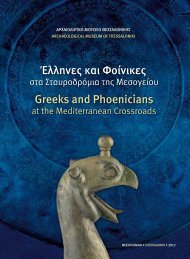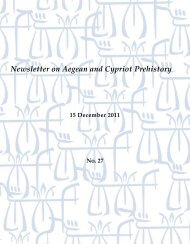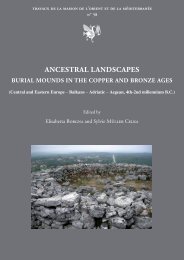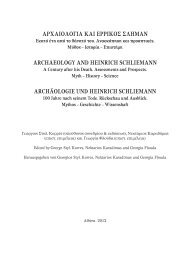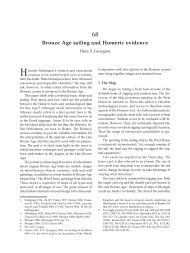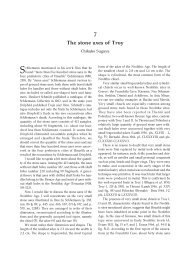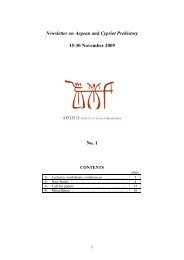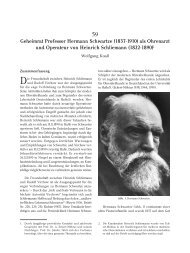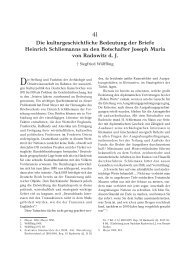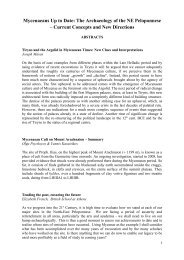MNEMONIC LANDSCAPES AND MONUMENTS OF THE PAST
MNEMONIC LANDSCAPES AND MONUMENTS OF THE PAST
MNEMONIC LANDSCAPES AND MONUMENTS OF THE PAST
You also want an ePaper? Increase the reach of your titles
YUMPU automatically turns print PDFs into web optimized ePapers that Google loves.
220 y. galanakis<br />
other local features like giant pithoi (storage jars) of the MBA may have also inspired its form. 3 It has been<br />
widely acknowledged that the earthen mounds of tumuli and tholos tombs would give a similar impression<br />
to the viewer by concealing the structural differences of the two funerary forms, on the assumption that<br />
all stone built tumuli were indeed covered by an earthen mound. It has also been proposed that tholoi<br />
constituted a logical extension and intensification of MBA status marking, 4 especially in Messenia, the area<br />
with the largest concentration of tumuli and early tholos tombs in the Aegean.<br />
In the present paper, I propose to explore the landscape associations between tumuli and tholos tombs<br />
in Messenia. 5 In doing so, I intend to place emphasis on issues of visibility, proximity and placement of the<br />
tombs in the landscape. After assessing the landscape associations of the two funerary forms, I would like<br />
to argue that although the visual continuity in the Messenian landscape may have made claims to the past,<br />
at the same time it was progressively appropriated to serve the needs for power display of rising local elites.<br />
I will finish by examining the site of Englianos, the site of the so-called “Palace of Nestor”, in an attempt<br />
to exemplify how in this particular case the placement of tholos tombs may have helped to transform the<br />
landscape into the ideal arena for power display.<br />
However, any attempt to discuss the issue of landscape associations is hampered by a number of<br />
obstacles. Very few tholos mounds have been thoroughly investigated and only a handful of MBA tumuli<br />
have been properly studied and published. In order to appreciate the setting and prominence of the tombs,<br />
further work is needed towards the reconstruction of the Aegean Bronze Age landscape, especially the area<br />
surrounding the tumuli and tholos tombs. 6 Additionally, it is very frustrating to have substantial funerary data<br />
and at the same time to know very little about the settlements with which the tombs were associated.<br />
MBA Tumuli (fig. 1)<br />
Despite sharing some basic characteristics, tumuli in the Aegean are almost individually idiosyncratic<br />
monuments. They are considerably diverse in their lifecycle, size, architecture, construction and the number<br />
and types of tombs they conceal. 7 MBA tumuli in the Aegean have a diameter ranging from 8 to 30m and a<br />
height ranging from 1 to 5m, meaning that some allowance must be made for the effects of erosion.<br />
The visual impact of Bronze Age tumuli in the Aegean should not be exaggerated. Most of them constituted<br />
simple earthen rises slightly swollen at the centre. 8 Taking into account the topography and geomorphology of<br />
the Greek landscape, and of Messenia in particular, it becomes apparent that in the majority of cases the visual<br />
impact (the physical prominence) of tumuli would have been limited at close quarters, unlike for example the<br />
vast grasslands of the steppes where mounds may have actually mapped the landscape. 9<br />
As far as the landscape associations of tumuli with tholos tombs are concerned, so far in only one<br />
instance in Messenia, at Voidokoilia, is an early tholos directly associated with an earlier tumulus (in this<br />
case of MH I date). The tholos, as shown by Professor Korres, was inserted almost in the centre of the<br />
MBA tumulus itself built over an EH II settlement. 10 This action might have constituted a direct claim<br />
3. Korres 1993, with earlier literature; Korres, this volume.<br />
4. Voutsaki 1995; Bennet 1998, p. 125; Boyd 2002.<br />
5. For MBA Messenia see also the recent review of new sites by Chasiakou and Korres 2006; for an overview see also<br />
Boyd 2002.<br />
6. A good example towards this direction is the work carried out by Zangger et al. 1997 for PRAP.<br />
7. Müller 1989.<br />
8. Pelon 1976; Cavanagh, Mee 1998.<br />
9. For a brief overview on tumuli in Europe see Harding 2000, p. 84-103.<br />
10. Korres 1993; outside Messenia, something similar is attested at Amparia Loutrakiou in west central Greece (see<br />
Müller Celka, this volume). The tombs at Kato Samiko, with the exception of the two () tholoi are here considered<br />
“grave circles”. I take into account only those tombs securely identified as tumuli.



